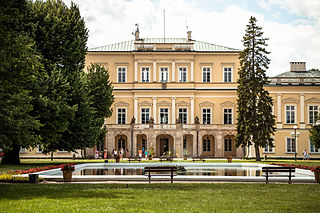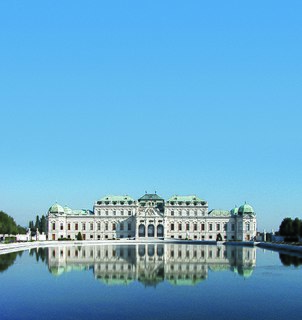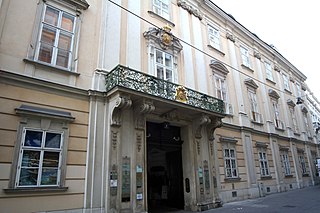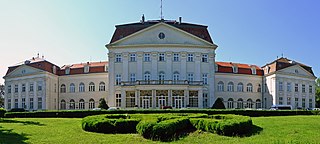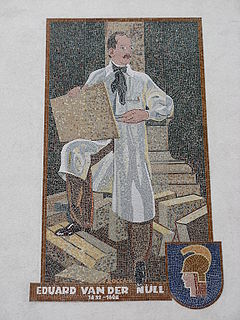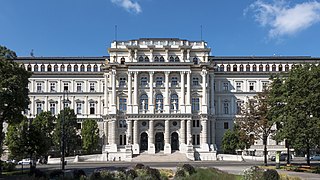

Czartoryski-Schlössel (Schlössel is roughly translatable as "small palace") was a palace called Weinhaus in the Währing district of Vienna, Austria. [1] It was built in 1807 for the banker Friedrich Jakob van der Nüll, the legal, but not biological father of architect Eduard van der Nüll. The palace was subsequently put up for sale and purchased by Prince Czartoryski[ which? ]; it remained in possession of the Czartoryski family until shortly after World War I.

A palace is a grand residence, especially a royal residence, or the home of a head of state or some other high-ranking dignitary, such as a bishop or archbishop.
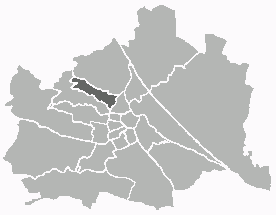
Währing is the 18th district of Vienna and lies in northwestern Vienna on the edge of the Vienna Woods. It was formed in 1892 from the unification of the older suburbs of Währing, Weinhaus, Gersthof, Pötzleinsdorf, Neustift am Walde and Salmannsdorf. In 1938 Neustift am Walde and Salmannsdorf were annexed to the neighbouring 19th District (Döbling). Because of several wealthy neighbourhoods, Währing is known today as one of Vienna’s upmarket districts, along with Döbling and Hietzing.

Vienna is the federal capital and largest city of Austria, and one of the nine states of Austria. Vienna is Austria's primate city, with a population of about 1.9 million, and its cultural, economic, and political centre. It is the 7th-largest city by population within city limits in the European Union. Until the beginning of the 20th century, it was the largest German-speaking city in the world, and before the splitting of the Austro-Hungarian Empire in World War I, the city had 2 million inhabitants. Today, it has the second largest number of German speakers after Berlin. Vienna is host to many major international organizations, including the United Nations and OPEC. The city is located in the eastern part of Austria and is close to the borders of the Czech Republic, Slovakia, and Hungary. These regions work together in a European Centrope border region. Along with nearby Bratislava, Vienna forms a metropolitan region with 3 million inhabitants. In 2001, the city centre was designated a UNESCO World Heritage Site. In July 2017 it was moved to the list of World Heritage in Danger.
The three-storey-high palace was designed in the Empire style. The layout was shaped like a horseshoe, with a central part (Mitteltrakt) and two side wings. The building was set back from the street by a courtyard, protected by a wrought-iron fence with a gate. Before selling the palace, the Prince had the expensive inlaid doors and wooden floor removed and transported to his estate in Pełkinie near Jarosław, Galicia, where they were destroyed in a fire during World War I. The palace's remaining features included the elaborate ceiling in the former library, showing depictions of mythological scenes, as well as the stucco in the former gallery.

Pełkinie is a village in the administrative district of Gmina Jarosław, within Jarosław County, Subcarpathian Voivodeship, in south-eastern Poland. It lies approximately 7 kilometres (4 mi) north-west of Jarosław and 46 km (29 mi) east of the regional capital Rzeszów.
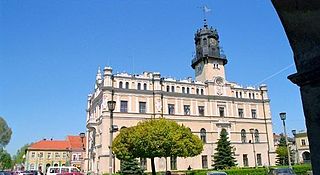
Jarosław is a town in south-eastern Poland, with 38,970 inhabitants, as of 30 June 2014. Situated in the Subcarpathian Voivodeship, previously in Przemyśl Voivodeship (1975–1998), it is the capital of Jarosław County.

Stucco or render is a material made of aggregates, a binder, and water. Stucco is applied wet and hardens to a very dense solid. It is used as a decorative coating for walls and ceilings, and as a sculptural and artistic material in architecture. Stucco may be used to cover less visually appealing construction materials, such as metal, concrete, cinder block, or clay brick and adobe.
After the palace was renovated in 1923, it re-opened as a children's home. The building suffered slight damage during World War II, and subsequently fell into neglect. It was torn down in 1957 to make way for a modern school building, completed in 1959. [2]
